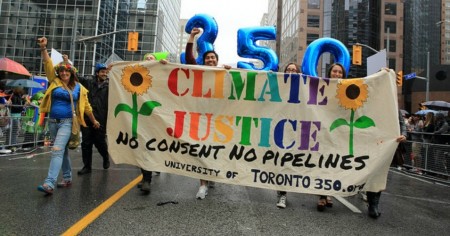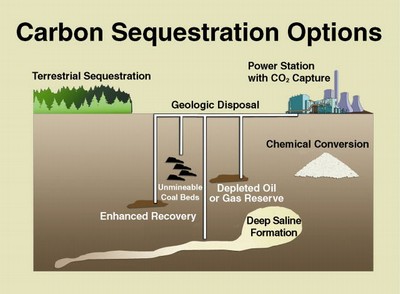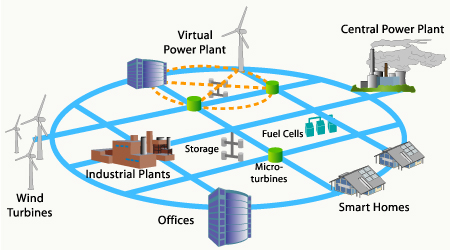July 5, 2015 – Marchers have gathered here in Toronto for a mass demonstration in support of “climate justice.” The moving force behind what is expected to be a worldwide street protest is 350.org, a social media phenomenon that is becoming the organized focus for fighting against government and corporate indifference to combating climate change more aggressively.
Today there is no uncertainty that the buildup of C02 in the atmosphere poses a clear and present danger. It is already impacting global health with diseases only seen in the tropics and semitropical zones migrating into temperate and even polar regions. Measuring human suffering let alone the suffering of wildlife and domestic animals, climate change is starting to impact our way of life in a slow death of a thousand cuts. The toll on human civilization over the next century will amount to trillions of dollars and yet we have the answer – cut emissions of greenhouse gases, not in small increments, but aggressively.
Of course even if we cut emissions of CO2 today those we have already created will continue to impact the atmosphere for a century or more and so we will pay for our past for some time to come. Under best case scenarios in which we aggressively cut future CO2 emissions by half over the next two decades, we will still encounter shifting climate zones, sea level rise, ocean acidification and freshwater scarcity.
So what to do besides countries agreeing to cut future emissions, carbon intensity per unit of production, and the switch to renewables?
To suddenly turn off the switch on industries that burn fossil fuels to manufacture, and utilities that use fossil fuels to generate energy would achieve economic disruption on a colossal scale. I’m sure some demonstrating today on the streets of Toronto think that the pain of doing this would be ultimately worth it. But such a strategy is exactly why leaders like Canada’s Prime Minister, Steven Harper, choose to downplay climate change. No leader wants to be responsible for the econmic demise of his or her country and no CEO wants to deliberately dismantle his or her company. Having said that, however, no leader can responsibly ignore the issue which seems to be the strategy of choice of the Canadian federal government until very recently.
There is an answer in how to address climate change responsibly and it comes in three parts:
1. We need to suck CO2 from the atmosphere at greater rates than our current economic engines produce it. That means rapid expansion of natural carbon sinks. A typical tree sequesters 22 kilograms (48 pounds) of CO2 per year. A hectare (2.47 acres) of new forest sucks up 6.17 tons of CO2 annually. So reforestation on a significant scale can begin to put a small dent in greenhouse gas emissions but we would need to be thinking billions of hectares of new forest to overcome the gigatons our industries and energy producers output in a year. Of course we have no intention of taking productive farmland offline and turning into forests. But we can end widespread deforestation and clear cutting practices in the lumber and pulp and paper industry. And we can repopulate existing forests and plant trees where the land is deemed to be only marginally suitable for agriculture use.
2. A second way to suck CO2 out of the air involves using technology. But until recently both manufacturers and energy producers have paid lip service to carbon capture and sequestration (CCS), and carbon capture and use (CCU). There have been proposals to build artificial trees that could suck a ton of CO2 from the atmosphere. These devices would have higher “leaf” density than natural trees and if manufactured by the millions could sequester more CO2 than any natural forest. One artificial tree technology calculates that 10 million units could drop atmospheric CO2 concentrations by 0.5 parts per million per year. But what to do with the trees after they become saturated with CO2? There are many industrial applications for C02 use but how much gas can be absorbed this way remains an unknown. More conventional CCS and CCU technologies involve stripping CO2 from the gas stream in industrial processes at the point of origin or at the smokestack and then liquefying and storing the gas underground or in products like cement blocks. These have been discussed frequently in postings here at 21st Century Tech blog and you can read about them by typing “CCS” or “CCU” in the “search” window feature provided by the website.
3. We need to change the way we produce and distribute energy. Today we have energy utilities acting as the prime power generators. The energy infrastructure is a grid that connects power generation sites to power consumers. But new sources of energy like solar, wind, tidal, wave and geothermal lend themselves to a more local distributed system model where the power is generated in proximity to the consumer. Rethinking and investing in research and development of an energy model that makes distributed power from renewable sources as reliable as power fed to us through a national or international grid would be money well spent. And we wouldn’t be limited to just renewables. New modular fission reactors using thorium, fusion technology, and even “cold fusion” should it become viable, could be added to the mix meaning a transition from current CO2 generating energy plants.
How to fund massive reforestation, CCS, CCU and distributed energy?
I have often described the investment in terms of being equivalent to a dozen or more “Manhattan Projects” a year. To put that in perspective, in 1940s dollars the cost of research and development (R&D) to build the atomic bomb amounted to $2 billion. In today’s dollars that is equivalent to $27 billion. Now multiply that by 12 and you get an annual investment of $324 billion. Heck the bank bailout in 2008 was a bigger number than that. So the minimal annual R&D investment government should be making to address CO2 reduction is less than the money spent to prop up the banks in the economic meltdown of 2008.
Where would the money come from?
A carbon tax levied on every ton of CO2 produced at the point of origin whether manufacturing, energy production or at the transportation tail pipe. In the case of the latter it would applied to the cost of fuel. Governments could devise ways to offset the burden of the tax for those most economically vulnerable.
Costs described in terms of R&D investment don’t cover mitigation and adaptation dollars that government will need to spend to deal with the century or more of continued CO2 rise while the solutions are developed to a point where they begin to create a net reduction in the greenhouse gas. Those costs are estimated in the trillions and will be spent on cleaning up damage from extreme weather events, adapting coastal cities and resettlement of populations because of sea level rise, conservation and hardening of infrastructure to deal with drought, freshwater scarcity, food security and other issues.
For today’s marchers here in Toronto and in other cities around the world, it should be understood that climate justice comes at a price. We’ll all be winners in the end but we need to map the strategy, put a dollar figure to it, and then address it and measure our progress with scientific rigor. And like any large R&D investment we can expect failures along the way, and hopefully by the end of the 21st century see CO2 declines with every drop of one part per million declared a small victory.











[…] Toronto and other cities are witnessing street protests demanding "climate justice." Posting outlines three steps and costs to achieve this. […]